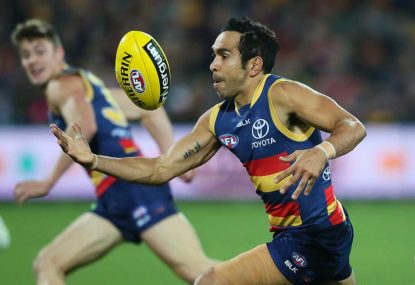In a sea of negative press towards AFL teams failing to meet pre-season expectations, one club is making waves and working its way into contention: the hustling, bustling, high-scoring Adelaide Crows.
The football world’s attention is focussed on the underperformers after three rounds: Richmond, Collingwood and Fremantle.
That is to be expected, given the former and latter were expected to feature heavily in September, and the Pies were a fashionable finals bolter. Many have written off their hopes, which again, while to be expected, remains somewhat premature.
These three teams all have problems, and they all centre on ball use. The Tigers seem to change their identity by the quarter, morphing from a ball control kick-and-mark operation into a handball-happy runner in the space of 30 minutes; they can do neither of these things particularly well at the moment.
Collingwood have been six shades of diabolical with the ball in hand, but have backed that up with the defensive prowess of 18 James Hardens. And Fremantle’s pivot to a more attacking mode seems to have backfired, again, on the back of some remarkably poor ball use, both by way of decision and execution.
You know who has been the opposite of all of these things? The Western Bulldogs, yes, but also the Adelaide Crows.
The Crows were a fashionable slider coming into the year, with most pundits – including yours truly – predicting a dip out of the final eight in 2016. Much of the analysis centred on how the Crows would adapt to life without their Batman in Patrick Dangerfield. I had a bit of a crack at this in February, noting Dangerfield’s departure, along with the arrival of a new coach in Don Pyke, afforded the Crows an opportunity to recast their identity.
I saw the Crows as better than a 0.500 team, capable of making the eight, but in the end I left them out because of the teams I saw with potential to overtake them – or at least get to the same ‘very good’ level that Adelaide exhibited last season. That call looks a touch silly now, given the Crows sit within a missed Eddie Betts sitter in Round 1 of being 3-0 against a quality slate of opponents.
With the Tigers and Dockers looking sick, and the Swans still yet to convince anyone they aren’t the 2014 version of the West Coast Eagles (not by their own doing, they’re just yet to play any of the bonafide 2016 teams), a top-four spot looks open to the field.
Could Adelaide take it? You better believe it.
Solid foundations
When they were rolling in 2015, the Crows were an inside-dominant tour de force, employing a scheme which had them in good stead as a default option. Adelaide were third in the league with a lofty +9.5 contested possession differential per game, and that translated into a moderate territory advantage (+4.7 inside 50s per game). This was enabled by their three-pronged ball-winning set through the middle: Dangerfield, Scott Thompson and Rory Sloane, who were all in the top 20 for contested possession wins on the season.
But their scheme evidently left them short against teams with good skills or team defence – and the key proponent of it, Dangerfield, just straight up left.
Adelaide had a full-season uncontested possession differential of -16.0, while every other team that had a positive full year result in the contest also had a positive count on the outside.
It was the great uncertainty heading into the year: could Adelaide still be Adelaide without their best ball winner? The answer, early on at least, is no. Scott Thompson is playing out of his mind for a player that supposedly peaked five years ago, and Matt Crouch has managed to pick up a decent chunk of the slack created by Dangerfield’s departure. Notwithstanding, the Crows haven’t discovered their balls-to-the-wall best at the contest from years gone by.
But what they have managed at this point is a far more balanced style of play, which blends their ball-winning prowess with a more sharp and incisive outside attack. In addition, Pyke looks to have decided that the best way to improve Adelaide’s shaky defensive set is to employ more specialists, in a manner which has made the Crows’ forward line one of the most dominant and effective in the competition.
To this point, it is working an absolute treat.
Another string to their bow
The most noticeable feature of Adelaide’s game is the way they are attacking off of the half back line. The Crows have always been a kick-first team, recording the second-largest kick-to-handball ratio in the competition last year (behind the Gold Coast Suns), but their ability to do so effectively has improved markedly in the off-season.
They have had weapons in Brodie Smith and Rory Laird for some time, but never took full advantage of them, instead content to press hard and force turnovers closer to their attacking zone. The Crows of 2015 would commit numbers to the ball, opening themselves up on counter-attack and exposing an under-manned back six – notwithstanding the presence of the effective Daniel Talia. This scheme relied upon quick rebounds, but of the imprecise variety.
The 2016 Crows are still relying on a hard press, but are instead being much more careful and structured in how they use the ball going forward. This is particularly true of opportunities to attack the wings, where the bomb and hope days of yesteryear have given way to quick, precise kicking. And more importantly, the ball is in the hands of Laird and Smith more frequently.
Laird is running second in total disposals (and third in kicks) and Smith first in kicks (and third in disposals) at Adelaide so far this year, and both are doing so almost exclusively on the outside of the play. Both are pushing 80 per cent disposal efficiency. Their possession maps for the first three rounds point to two players given license to set the play, rather than responding to it and simply putting the ball into the attacking half of the ground.
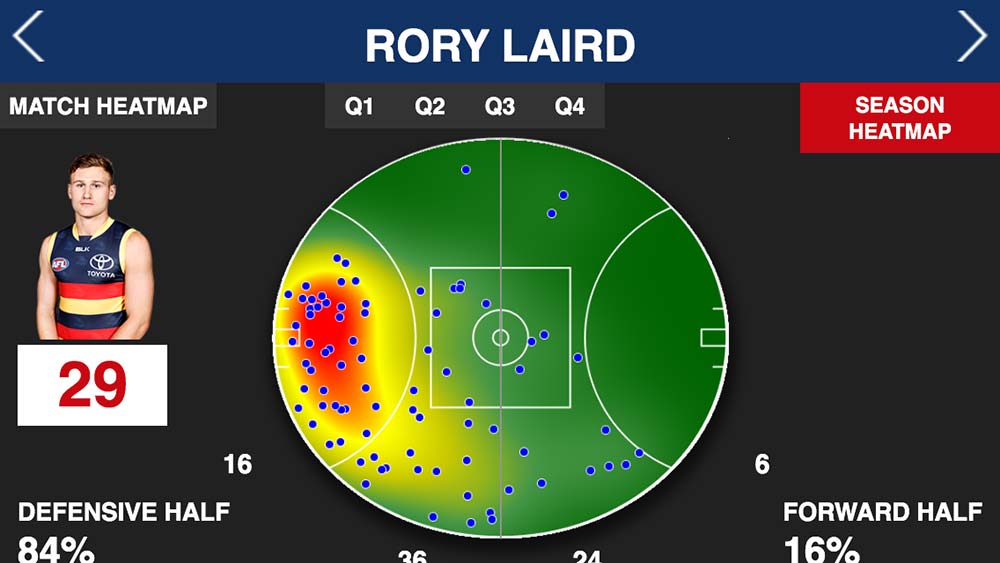
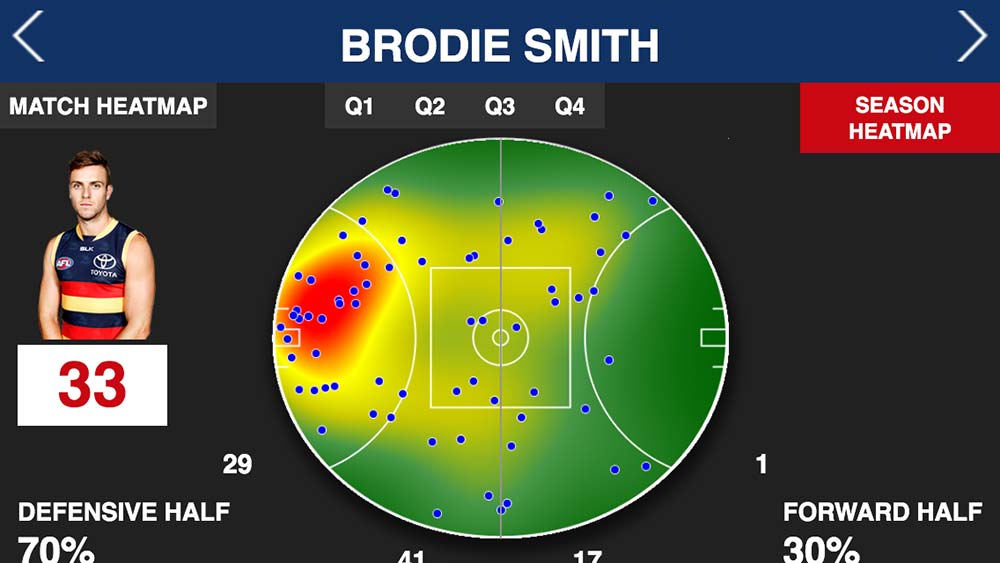
Source: afl.com.au
With these two given more ownership of the attacking side of the game, the Crows are relying more on defensive midfield than in the past. The chief proponent of this has been Sloane, who has spent more time in the defensive half of the ground in 2016 than in seasons past, bringing his ground ball skills to bear as support for the defenders when the attacking thrusts don’t come off.
The Crows are also leaving more defenders at home to play as more pure defensive stoppers, with Jake Lever and Kyle Cheney doing almost all of their work inside defensive 50. The duo, in conjunction with general Talia, have the potential to form an intercepting triumvirate not unlike the star trio at Hawthorn.
The system Pyke has begun implementing should allow the Crows to put their incredibly effective forward line to maximum use. But it does have its drawbacks.
Adelaide have lost the inside 50 count in two of their games this season, with a narrow victory over the Tigers (57-53) courtesy of them putting the cue in the rack in the final quarter. The territory game was a strength of theirs in 2015, and top six sides are more likely to make the Crows pay on the way back. Richmond managed to penetrate Adelaide’s midfield zone with great ease in the weekend just passed, but some combination of Adelaide’s defence and Richmond’s poor method of moving into attack meant it didn’t translate into points.
But maybe Adelaide’s territory game doesn’t matter anymore? Adelaide’s attacking gameplan – which has to this point meant they lead the league in points per game and my Offensive Efficiency Rating (they’re back!) – may be effective enough to reduce the need for the Crows to win the territory battle.
Forward efficiency
Adelaide’s specialist forward set have collectively started off 2016 where they left off in 2015 – at least before their semi-final loss – and have reinforced claims that they have the best group of forwards in the competition. Sorry, West Coast, but you’ve been reeled in.
The three-headed hydra of Taylor Walker, Josh Jenkins and Tom Lynch are perfect complements, and have played off of each other’s strengths perfectly in the first three rounds of this season. Jenkins is the big bodied, more traditional full forward, Walker the leading target with a murderous right boot, and Lynch is the link man, making good decisions with ball in hand.
And then there’s Eddie Betts. One national football writer of prominence thinks it is time we started to talk about Betts – like he’s not watched a single game of Adelaide football for the past two and a bit years. Betts is the cream on the hulking Adelaide cake inside 50, but is a strong enough threat as a contested ball winner that he can, and does, spend plenty of time higher up the ground.
Some people like to refer to the Western Bulldogs’ Jake Stringer as ‘the package’, in reference to his all-around game. Well, I hate to burst this bubble (actually I don’t), but Betts averaged more goals, more marks (contested and uncontested), more contested possessions, and more tackles than Stringer in 2015, and he’s doing the same so far in 2016.
Damien Hardwick played his best defender, and the AFL’s best defender, Jedi Knight Alex Rance, on Betts over the weekend, despite Adelaide’s tall forward line (which was sans Lynch, but included Mitch McGovern).
The quartet are so potent that it leaves opposition defences scrambling, both when the ball comes in quickly or patiently and deliberately. It creates half a dozen opportunities per game for Adelaide’s rising half backs to sweep up the ground and kick uncontested goals from outside 50. Here’s one such example from the weekend.

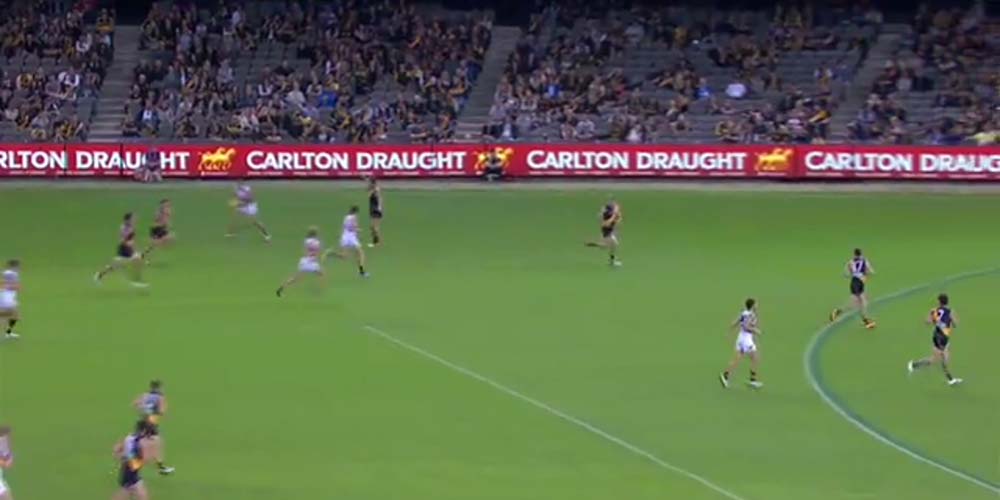

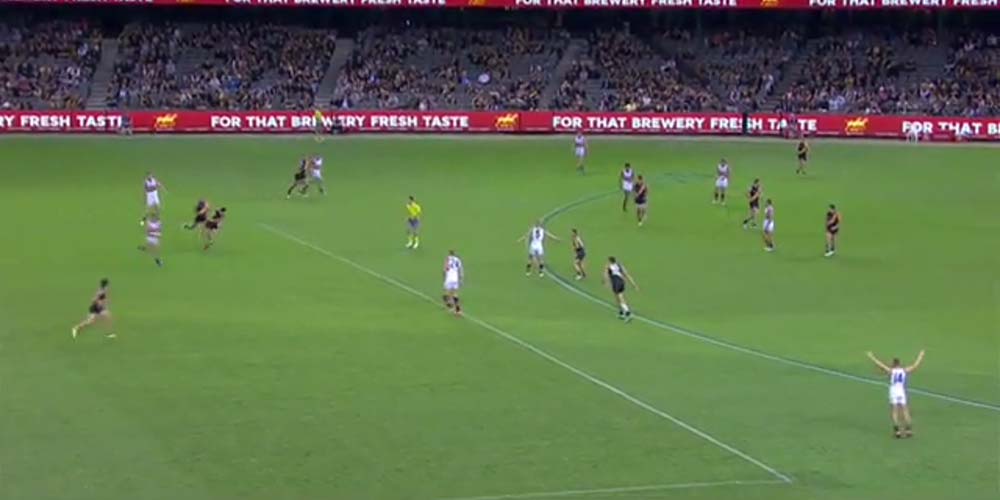
Adelaide are scoring on a crazy-good 56 per cent of their inside 50 entries in 2016, third behind North Melbourne and, strangely, Brisbane.
North Melbourne are another team that we have proven to be grossly pessimistic on as a punditry collective, although their draw has proven to be much more of a cakewalk than the Crows. Their attacking claws have been sharpened by the addition of a fit-again Daniel Wells, and an All-Australian contender in Brent Harvey. There’s plenty happening here – watch this space.
By way of comparison, the elite attacking unit at Hawthorn are running at a 49 per cent clip, and went at a similar mark in 2015. Now, Adelaide’s figure will fall over the year, but it is a measure of how well this unit can perform on its day – and so far its day has spread over three rounds of football.
This is all coalescing into a side that plays a brand of football perfect for the season we’re having right now; teams that can move the ball fast, precisely, or preferably both, are splitting the finely crafted defensive zones of their opposition apart. Pyke’s twists on a well-worn and effective gameplan are paying dividends to this point in the year.
Before the season, I said on The Roar AFL Podcast that Adelaide’s first eight rounds would define their season. It included a stretch of games that looked, from the haze of February, like a particularly brutal episode of Takeshi’s Castle: North Melbourne, Port Adelaide, Richmond, Sydney, Hawthorn, Fremantle, the Western Bulldogs and Geelong – alternating away and home. A 4-4 split would elevate the Crows into contention for a finals spot.
To this point, they’ve taken all that has come to them, and impressed in every facet of the game. Their 2-1 record with no percentage-boosting games like those gifted to teams above them on the ladder – driven by the vagaries of the draw, nothing more – hide that the Crows have the best strength-of-schedule-adjusted percentage in the league.
That 4-4 start is most certainly in reach, and with it, so is a finals berth. Start the year with five wins, or even six, which is in play, and the Adelaide Crows are in the frame for a top-four spot. It starts this weekend, with the Crows hosting Sydney to provide the Swans with their second real test of the year.
Adelaide’s counter-punching style meeting Sydney’s wide-open, run-and-carry brand has the potential to be another super high-scoring game. Sydney’s defence will be under pressure from the first minute, and I’m doubtful that they have the pace to go with the flexibility that Adelaide’s set affords. The Swans will also have to decide what to do with the rebounding Laird and Smith; it could be an excellent opportunity to see what youngster Isaac Heeney has got as an attacking wing man.
An Adelaide win here would be considered a bonus. Games against Fremantle and Geelong at home look like prospective wins from here, while a trip to the Western Bulldogs at their torture chamber in Round 7 already has me salivating.
Patrick… what was his name again?





























































































